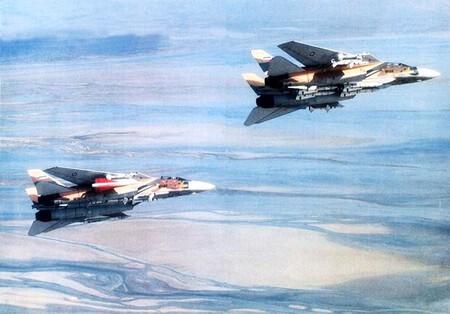While the missiles cross the air between Israel and Iran, the Israeli Air Force has confirmed a new attack on facilities close to Tehran. According to its version, among the objectives there were at least a couple of fighters F-14 Tomcat. In one of the available videos, the impact on what would be one of the few units that are still in service, almost half a century after having been manufactured.
That an American hunt retired in 2006 continues today flying in one of Washington’s great adversaries is no accident. The explanation is in the convoluted – sometimes contradictory – that history can be.
An order, a revolution and a war
The History of the F-14 in Iran begins in the 70s. The SHA, still strategic ally of the United States, decided to incorporate dozens of Tomcat fighters into its Air Force, in a military package valued at approximately 2,000 million dollars. To do this, he sent his pilots to train in California.
But everything changed in 1979, with the Islamic revolution. The relationship between Iran and the United States deteriorated quickly. Ayatolá Ruhollah Jomeiní ordered the arrest of many of those pilots and left the F-14 on land. But the situation took a new turn in 1980, when Iraq invaded Iran. The authorities decided to free the aviators, and began a career to counterreloj for reactivating a fleet for which there were no longer spare parts.
An Iranian pilot next to an F-14
Now, keeping an F-14 in flight is not an easy task. Every flight hour required many more maintenance, and many of its components were impossible to manufacture locally. Without access to Western technology, they would turn to smugglers, to the black market … and also, in a maneuver as surprising as documented, to the United States. During the 80s, within the framework of the Iran-Constra scandal, the administration of Ronald Reagan secretly authorized the sale of weapons to Tehran in exchange for the release of hostages.

Iranian Tomcats equipped with multiple missiles in full flight
Today, almost half a century after that SHA request, the F-14 Tomcat It continues to appear In Iran. There are no official figures on how many are or how many are really operational. Some have seen in parades. Others, in blurred videos. And now, according to Israel, at least two would have been destroyed in a recent attack near Tehran.

Israeli Air Force announced the impact on Iranian F-14 with this publication
That an F-14 is still present in 2025 is not just a technical rarity. It is a string of how convoluted the story can be. A hunt designed for US carriers, designed to face the Soviet Union and retired almost twenty years ago, still appears – in one way or another – in one of the most serious military tensions of the moment.
Tomcat was a technological feat. But he is also an unlikely survivor: he went from ally to enemy, he sustained thanks to improvised engineers, to clandestine networks, and the carelessness of those who tried to leave him on the ground forever.
Images | Nasim News Agency | IIAF | Shahram Sharifi | IAF 2 EEUU Marine (see Commons Wikimedia)
In WorldOfSoftware | If the question is how much the iron dome of Israel can endure, the answer is simple: much more than Iran’s defenses
